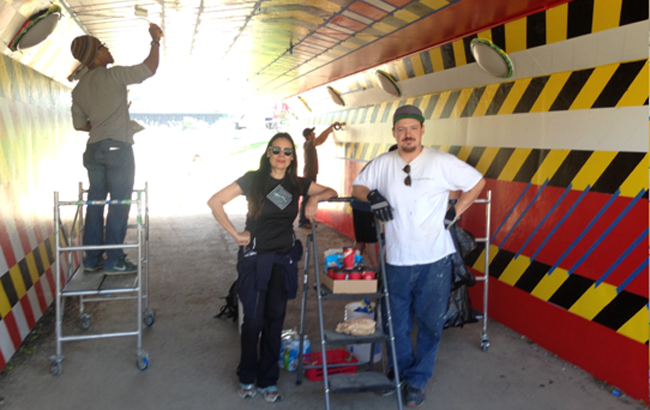Michipicoten artist painting tunnel in Toronto

By Rick Garrick
Michipicoten’s Rolande Souliere is creating Indigenous street art in the Bala Pedestrian Underpass, which is located on the traditional lands of the Mississaugas of the New Credit.
“It’s totally different from all the other art works that have been commissioned by the city,” Souliere says. “This one is really going to stand out because it is really intense, it’s bright. People are going to be going through the tunnel, whether on bikes or foot.”
Souliere says the art work draws attention to the longstanding 200-plus year land claim that the Mississaugas of the New Credit settled with the federal government in 2010 for $145 million. The community originally gave up the land, which covers Toronto and surrounding territory, in the 1787 Toronto Purchase and the 1805 Indenture.
“The zigzagging of the patterns and the little bit of pulsating through the movement of the pattern draws reference to the land claims,” Souliere says, “to the trail paths, to the summer grounds, to the redevelopment and of course the movement of the Mississaugas.”
Souliere says the Mississaugas of the New Credit will take part in the unveiling ceremony for her work, which is scheduled for the beginning of October. “We’re thinking of having some hand drums and dancers,” Souliere says. “And I’m also thinking of getting some contemporary First Nations dancers as well because it is a very contemporary art work.”
The underpass connects Corktown Commons Park with the Lower Don Valley Trail in Toronto. Souliere’s project is part of the StreetARToronto initiative, which was designed to develop, support, promote and increase awareness of street art and its role in adding beauty and character to neighbourhoods throughout the city.
“The city is paying for it — that is part of their anti-graffiti Toronto project,” Souliere says. “They’ve hired numerous artists to go throughout the city and turn these boring tunnel areas into art. They will actually have art tours, so people will be able to (take) tours through all the tunnel and mill projects.”
Souliere’s design was chosen through an Expression of Interest competition for a mural representative of the local, historical Indigenous perspective. She projected an image of her design onto the underpass for Jason Rouleau, a local artist who is well known for his street murals, to use as a guideline while painting the 150 square metre surface.
“He’s painted the Rising Phoenix here in Toronto on Wellesley Street,” Souliere says. “He calls himself a reformed graffiti artist.”
Souliere says Rouleau has been enthusiastic about the project. “I’ve given him the pattern and I’ve been discussing with him how to do it in 3D,” Souliere says. “He has to actually make that 2D (image) 3D, so I meet with him on site and we go over little technical points on how to wrap it around or if one part of the design wasn’t included, we discuss how to paint a different part of it to match the outside of the pattern. Souliere says many passersby along the underpass have expressed interest in how the completed project will look.
“Right now it is quite choppy, with stripes of red and some black going through,” Souliere says.
Souliere is currently working on her PhD in Visual Arts at the Sydney College of the Arts in Australia. She is an Australian citizen.


